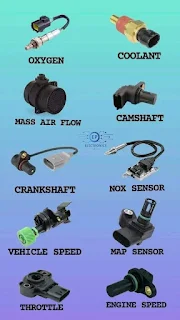✍️1. Oxygen Sensor: An oxygen sensor or probe or sensor, is an electronic device that measures the proportion of oxygen in the gas or liquid being analyzed.
✍️ 2. Coolant Sensor: A coolant sensor is a device that measures the temperature of the coolant in a vehicle's engine or the level of coolant in the system.
✍️ 3. Mass Air Flow Sensor: A mass flow sensor is a sensor used to determine the mass flow rate of air entering a fuel-injected internal combustion engine.
✍️ 4. Camshaft Position Sensor: A camshaft position sensor (CMP) is a device that measures the rotation and position of an engine's camshaft.
✍️ 5. Crankshaft Position Sensor: A crank sensor is an electronic device used in an IC engine, both petrol and diesel, to monitor the position or rotational speed of the crankshaft.
✍️ 6. NOx Sensor: A nitrogen oxide sensor or NOₓ sensor is typically a high-temperature device built to detect nitrogen oxides in combustion environments such as an automobile, truck tailpipe, or smokestack.
✍️ 7. Vehicle Sensor: A wheel speed sensor or vehicle speed sensor is a type of tachometer. It is a sender device used for reading the speed of a vehicle's wheel rotation.
✍️ 8. MAP Sensor: The manifold absolute pressure sensor is one of the sensors used in an internal combustion engine's electronic control system.
✍️ 9. Throttle Position Sensor: A throttle position sensor is a sensor used to monitor the throttle body valve position for the ECU of an engine.
✍️ 10. Engine Speed Sensor: The crankshaft’s location and speed are tracked by the engine speed sensor. This sensor is installed on the crankshaft. It transmits data to the ECU after detecting the crankshaft position.

Comments
Post a Comment